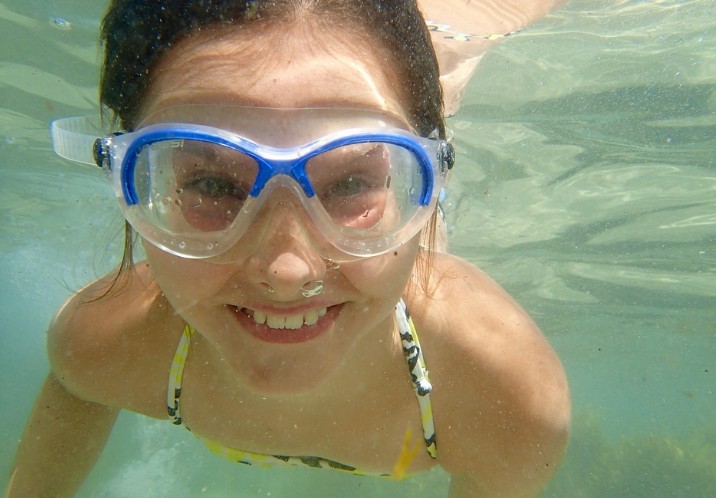When Can You Swim After a C-Section – Risks You Need to Know
Swimming puts your body under very little stress, making it the perfect exercise after a cesarean section. To learn when you can swim after a C-section, consult this guide.
Wait until your wound has stopped bleeding and is fully healed if you intend to go swimming soon after your procedure.
When Can I Swim After a C-Section?
Generally speaking, you must wait until your c-section incision is fully healed before going swimming. It can take approximately 6 weeks for the incision to close completely.
You cannot go swimming if there is any drainage coming from the incision, even if it is occasionally normal.
I strongly advise you to hold off until your postpartum checkup so your doctor can assess your incision.
The reason being that six layers of tissue were cut through during a c-section in order to remove your baby. (Muscles Cut During a C-Section has detailed information on the layers that are cut during the procedure.)
All of these layers require healing time. You run the risk of getting a wound infection if water gets inside of your incisions.
An infected wound must be opened up, occasionally in the operating room, and drained. In these situations, the wound is left untreated so that it can heal naturally.
Benefits
Swimming is a total-body workout that helps new mothers lose weight and tone their muscles, especially their abs. Simply because a C-section is open surgery, those who undergo one typically recover more slowly than those who give birth vaginally. It’s easy on your body because swimming is low impact. The water provides comfort for sore joints while minimizing pressure on your incision.
Where to Swim
For the first six weeks after giving birth, the APA advises women recovering from a C-section to stay away from public pools and hot tubs. The early stages of healing and potential incomplete closure of your incision put you at risk for infection during this time. Simply because so many people use public pools, they are more likely to contain germs and bacteria. The same issue could arise with lakes and other outdoor water sources. If your doctor gives the all-clear for you to swim during this time, lower your risks by swimming in a private pool that has a small number of other people using the equipment.
Take It Slow
Return to swimming with a sensible workout intensity plan. You’ll need to start off gradually because your body has changed over the past year. For five to ten minutes, walk or perform range-of-motion exercises like knee bends, shoulder rolls, and ankle rotations to prevent injury. For up to six months following childbirth, the American College of Obstetricians and Gynecologists advises maintaining a target heart rate of 50 percent. Find your maximum heart rate by deducting your age from 220. Then, while you’re exercising, take your pulse for 10 seconds, multiply the result by six, and that will give you your target heart rate. About half of your maximum rate should be used.
Can I Take a Bath Postpartum?
Similarly, you should not bathe postpartum for the same reasons listed above.
The risk of developing a uterine infection and/or a wound infection in any cuts or lacerations increases when you submerge your body underwater.
Having said that, taking a shower is totally acceptable. If your delivery went without a hitch, we advise taking a shower the following day.
Let your body and any incisions be washed by the warm, soapy water when you take a shower. Your cuts or laceration shouldn’t be actively scrubbed.
And after delivery, yes, soap can be used.
Simply be careful not to get soap inside your vagina. You run a higher chance of getting endometritis and/or bacterial vaginosis as a result (more on that later).
Why Can’t I Go Swimming 2 Weeks Postpartum?
Due to the extremely high risk of infection, you shouldn’t swim two weeks after giving birth.
By submerging your body underwater, you give bacteria access to any open wounds on your body.
It’s possible that you have episiotomies that need to heal, vaginal lacerations that need to mend, or recently undergone a c-section.
These are all common places for a nasty infection to spread.
You must still wait for your cervix to close even if you did not have a c-section or any vaginal lacerations. Otherwise, bacteria could enter your uterus and result in postpartum endometritis, an infection.
These infections can be serious, necessitating hospitalization and antibiotic treatment.

How Long Does It Take for Your Cervix to Close After Birth?
Regarding this, there is no absolute law. Generally speaking, once you stop bleeding vaginally, most medical professionals believe that your cervix has closed. This might take at least four weeks.
Remember that your cervix dilates to about 10 cm to allow your baby to come out.
Swimming in the Ocean After Birth- is It Advised?
Prior to thinking about going ocean swimming after giving birth, you should wait at least 6 weeks. The presence of numerous bacterial species in oceans is well known. Do not put your safety in jeopardy.
Prior to doing this, make sure you have a thorough evaluation from your doctor at your postpartum check-up.
Can I Go in a Pool After Giving Birth?
You can swim after giving birth, but only after your risk of getting an infection after giving birth has gone down.
A private pool is probably a safer place to swim than a lake or the ocean if you plan to go swimming.
This is true because chlorinated pools are less likely to be a haven for bacteria.
Having said that, I still advise you to hold off on entering a pool until your physician gives the all-clear. (4-6 weeks postpartum).
Is Swimming Good for Post Pregnancy?
Yes, there are many reasons why swimming is a great form of exercise during the postpartum period.
- it can improve your cardiovascular endurance,
- improve you muscle tone, and
- it can help you lose fat.
Swimming is a great postpartum workout because it is low-impact and easy on the joints. This implies that it won’t put strain on your joints.
What are the risks of exercising too soon postpartum? I’ve written an entire article about why your joints are very supple during this time.
However, swimming is not a weight-bearing activity. As a result, your bones and joints won’t get any stronger.
For that, you should also include some sort of weight-bearing exercise in the postpartum period, like walking, running, or weight training.
Swimming After Birth With Stitches – Does It Matter?
In general, you shouldn’t swim until your vaginal wounds have healed.
Although your stitches won’t actually dissolve for 10–12 weeks, the healing process can take anywhere from 4–6 weeks.
Most women who give birth vaginally will sustain a vaginal laceration. There are four different kinds of laceration.
- 1st degree: very superficial scrape in the vaginal tissue, sometimes requiring stitches
- 2nd degree: deeper laceration that requires stitching
- 3rd degree: a laceration that reaches the anal sphincter
- And 4th degree: a laceration that completely tears all the way through from your vagina into your rectum
Second-degree lacerations are the majority and do need suturing.
One continuous suture can be used to close the majority of lacerations. Other times, if you have multiple lacerations, you might need a few running stitches.
The most popular sutures are vicryl and chromic, both of which dissolve over time and don’t need to be removed.
In a similar vein, dissolving stitches are used to close almost all c-section incisions.
Therefore, yes, you can swim with stitches still in place, but only after your incisions have fully healed.
Can I Use Feminine Wash After Giving Birth?
Before or after giving birth, you are under no obligation to use any kind of feminine wash. Your vagina has a built-in mechanism for keeping itself clean.
By allowing vaginal bacteria to enter your uterus, using feminine washes and douches of any kind increases your risk of getting bacterial vaginosis or postpartum endometritis.
This illness is brought on by an imbalance of the good and bad bacteria in your vagina.
In other words, there is an overgrowth of the “bad” bacteria.
You see, the balance between good and bad bacteria in your vagina is normally perfect. There can be a homeostasis that can be disturbed by adding various products.
Increased vaginal discharge, itching, and a fishy vaginal odor are typical symptoms of bacterial vaginosis.
As a result, think of yourself. Do not use feminine products!
Can I Use a Tampon for Swimming After Childbirth?
Additionally, I advise against using a tampon while swimming. Tampons are an excellent place for bacteria to live, especially if you use one while swimming.
Additionally, you shouldn’t use any tampons during the first few days after giving birth. Allow your cervix to close so that your vaginal injuries can first heal.
Final Thoughts on Swimming After a Baby
Swimming is a great way to resume an exercise program after giving birth.
As with all types of exercise and physical activity, it is important that you get an okay from your doctor before starting.
Before going swimming, you must wait at least 4-6 weeks for any lacerations, episiotomies, or cesarean deliveries to heal completely.
FAQs
Can I Go Swimming 3 Weeks After Giving Birth
Swimming. If you want to go swimming, you’ll need to wait until any discharge (lochia) has stopped and any stitches have healed. This is most likely starting at around six weeks.
How Soon After a C Section Can You Fly
If you had a caesarean section, you might have to hold off on taking to the skies until after your six-week postnatal check-up. Even then, you should only fly when your GP gives you the all clear.
